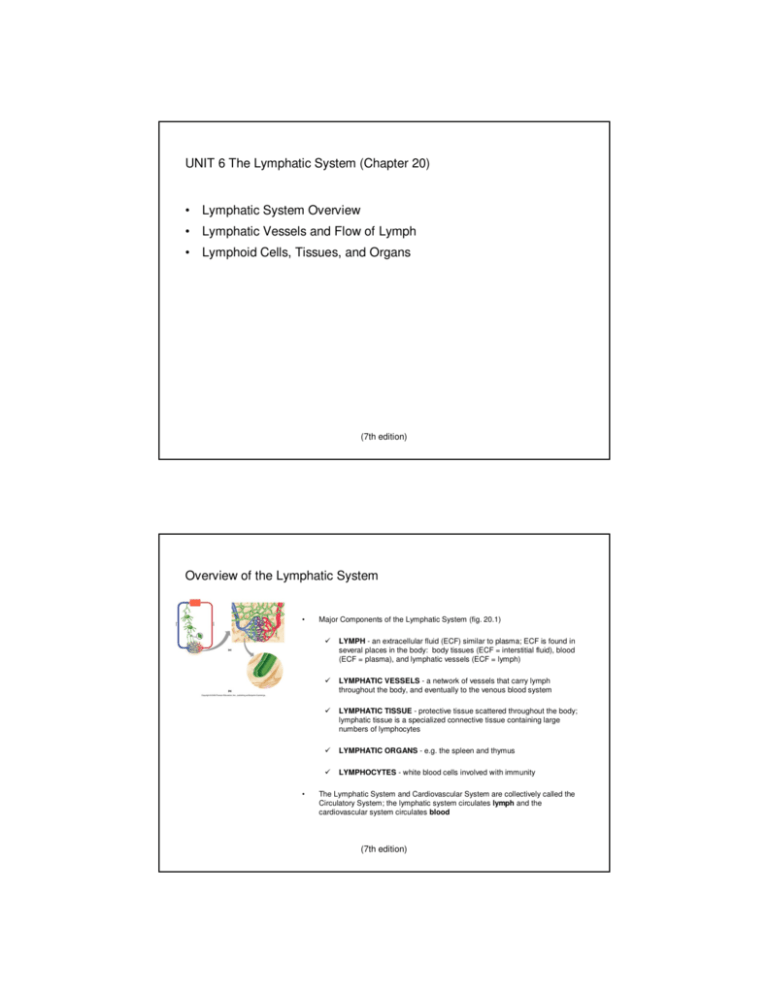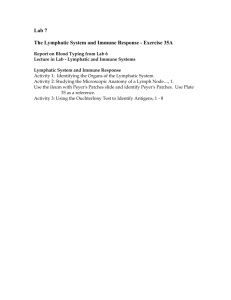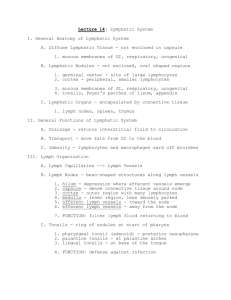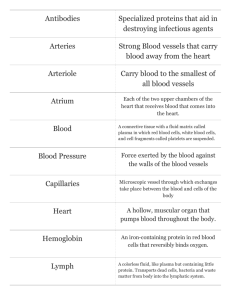
UNIT 6 The Lymphatic System (Chapter 20)
• Lymphatic System Overview
• Lymphatic Vessels and Flow of Lymph
• Lymphoid Cells, Tissues, and Organs
(7th edition)
Overview of the Lymphatic System
•
•
Major Components of the Lymphatic System (fig. 20.1)
LYMPH - an extracellular fluid (ECF) similar to plasma; ECF is found in
several places in the body: body tissues (ECF = interstitial fluid), blood
(ECF = plasma), and lymphatic vessels (ECF = lymph)
LYMPHATIC VESSELS - a network of vessels that carry lymph
throughout the body, and eventually to the venous blood system
LYMPHATIC TISSUE - protective tissue scattered throughout the body;
lymphatic tissue is a specialized connective tissue containing large
numbers of lymphocytes
LYMPHATIC ORGANS - e.g. the spleen and thymus
LYMPHOCYTES - white blood cells involved with immunity
The Lymphatic System and Cardiovascular System are collectively called the
Circulatory System; the lymphatic system circulates lymph and the
cardiovascular system circulates blood
(7th edition)
Overview of the Lymphatic System
Major Functions of the Lymphatic System:
•
•
•
fluid balance - excess interstitial fluid from tissue spaces (interstitial spaces) is returned to the blood by the
lymphatic capillaries; once interstitial fluid enters a lymphatic capillary it is called “lymph”
every day, about 30 liters of fluid leave your blood capillaries and enter the interstitial fluid of the body
tissues
approximately 27 of those liters are reabsorbed back into the blood capillaries
the remaining 3 liters move into the lymphatic capillaries, so that they are removed from the tissue
distribution - of hormones, nutrients, and waste products from the site of origin to general circulation
the lymphatic system absorbs fats from the small intestines, and lymphatic vessels carry the fats to the
bloodstream
transport of lipid-soluble vitamins (A, D, E, and K) from the gastrointestinal tract to the blood
defense - microorganisms and antigens are destroyed by WBCs
(7th edition)
Lymphatic Vessels and Lymph Flow
•
•
LYMPHATIC CAPILLARIES (fig. 20.1) - are found in most tissues of the body;
they differ from blood capillaries in several ways:
they originate as blind pockets; each of the lymphatic capillaries has one
closed end; extracellular fluid enters the lymphatic capillary through a
flap-like minivalve
they are larger in diameter than blood capillaries
they have thinner walls than blood capillaries
there are gaps between the endothelial cells that comprise the wall of the
lymphatic capillary making them more porous; fluids can enter the
lymphatic capillary but cannot leave
Lymphatic vessels - resemble veins in structure; from the capillaries, lymph
moves into lymphatic vessels; they contain valves which keep the lymph
moving in one direction through these low pressure vessels
(7th edition)
Lymphatic Vessels and Lymph Flow
•
In general a tissue will contain many more lymphatic vessels than veins but
they will be much smaller
•
Lymph moves in response to:
•
contraction of surrounding skeletal muscles (remember that veins return
blood to the heart using a similar mechanism); like veins, lymph vessels
have valves to keep the fluid moving in one direction
contraction of smooth muscle in wall of the lymphatic vessel
pressure changes in the thoracic cavity during respiration
Major lymph-collecting vessels: (fig. 20.2)
THORACIC DUCT - largest lymph vessel; drains into the left subclavian
vein; drains the entire body except the upper right quarter
CYSTERNA CHYLI - expanded abdominal portion of the thoracic duct;
this is where fat-filled vessels from the digestive tract enter the lymphatic
system
RIGHT LYMPHATIC DUCT - drains lymph from the upper right quarter of
the body; drains into the right subclavian vein
(7th edition)
Lymphoid Cells, Tissues, and Organs
•
•
Types of Lymphocytes:
T CELLS (T lymphocytes) - attack foreign cells or body cells infected by viruses; T cells mature and divide
in the thymus; T cells are responsible for cell-mediated immunity (meaning that the protection is directly
from living cells)
B CELLS (B lymphocytes) - responsible for antibody-mediated immunity (=humoral immunity); a
percentage of circulating B lymphocytes mature into PLASMA CELLS; plasma cells produce and secrete
antibodies which destroy antigens
NK CELLS (natural killer cells) - attack foreign cells and cells infected with viruses and cancer cells
LYMPHOID NODULES - lymphocytes densely packed into an area of areolar tissue
occur in the connective tissue deep to the epithelia that line the respiratory, digestive, and urinary tracts
have a central zone called a germinal center which contains dividing lymphocytes
the boundaries of the nodule are not distinct because they have no fibrous capsule surrounding them
(7th edition)
Lymphoid Cells, Tissues, and Organs
•
LYMPH NODES (fig. 20.4)
small oval lymphoid organs distributed along the lymphatic vessels; each
lymph node is covered by a capsule of dense fibrous connective tissue;
connective tissue strands call trabeculae extend inward to divide the node
into compartments
they filter the lymph, removing bacteria and antigens
lymphocytes congregate, function, and proliferate in the lymph nodes
lymph nodes are found throughout the body: superficial aggregations of lymph
nodes are found in the inguinal, axillary, and cervical regions
afferent lymphatic vessel - lymph vessel that carries lymph to the lymph
node; as lymph flows through the lymph node it is exposed to B and T cells
and macrophages; at least 99% of the pathogens in the lymph are removed
efferent lymphatic vessel - lymph vessel that carries lymph away from the
lymph node
(7th edition)
Lymphoid Cells, Tissues, and Organs
SPLEEN
•
located in the superior, posterior, left abdominal cavity (fig. 20.5)
•
contains the largest collection of lymphoid tissue in the body
•
performs the same function for blood that lymph nodes perform for lymph; the spleen filters
the blood and is involved with:
removal of abnormal blood cells and other blood components by phagocytosis
storage of iron from recycled RBCs
initiation of immune responses by B cells and T cells in response to antigens in
circulating blood
•
the spleen also acts as a blood reservoir
•
RED PULP vs. WHITE PULP:
red pulp - area of the spleen that contains large numbers of RBCs; the structural
framework of the red pulp consists of a network of reticular fibers; it is rich in
macrophages; red pulp is mainly concerned with disposing of worn-out red blood cells
and bloodbourne pathogens
white pulp - area of the spleen that resembles lymphoid nodules; it is composed
mostly of lymphocytes suspended on reticular fibers, and is involved with the immune
functions of the spleen
(7th edition)
Lymphoid Cells, Tissues, and Organs
•
•
•
TONSILS
Large lymphoid nodules in the walls of the pharynx and oral cavity (fig. 20.5)
pharyngeal tonsil - also called the “adenoids” is located in the posterior superior wall
of the nasopharynx
palatine tonsils - a pair of tonsils located at the posterior margin of the oral cavity
along the border along its boundary with the oropharynx
lingual tonsil - located under the attached base of the tongue
PEYER’S PATCHES
Peyer's patches are clusters of lymphoid nodules deep to the epithelial lining of the
small intestine (fig. 20.5)
contain lymphocytes and macrophages which remove microorganisms, debris, and
antigens from the digestive tract
APPENDIX - large concentrations of lymphoid tissue are located in the wall of the appendix;
thus, the appendix has some lymphatic function (fig. 20.5)
(7th edition)
NOTE: For a good review of some of what we have just covered in the
lymphatic system, view the Interactive Physiology tutorial “The Immune
System: Anatomy Review”; it is located in Chapter 21 of the textbook
website
(7th edition)
This concludes the current lecture topic
• Be sure to read the next lecture topic: Immunity (Chapter 21)
(close the current window to exit the PowerPoint and return to the
Unit 6 Startpage)
All text contained in this PowerPoint is covered by the following Copyright:
Copyright© 2009. Robert Wakefield. All rights reserved. To request permission to use materials contained on this
website please send an email to Robert Wakefield at rwakefield@pima.edu
(7th edition)









